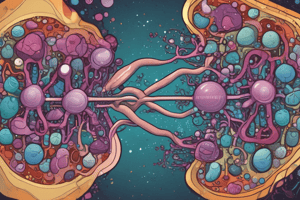Podcast
Questions and Answers
How does the conversion of androgens to estrogens in peripheral tissues contribute to estrogen levels in men and postmenopausal women?
How does the conversion of androgens to estrogens in peripheral tissues contribute to estrogen levels in men and postmenopausal women?
In men and postmenopausal women, most estrogens present in the circulation are derived from the conversion of testicular, adrenal, and ovarian androgens in peripheral tissues, primarily adipose tissue, and skin.
Explain the role of progestogens in preparing the uterine lining and how it relates to the hormone's function during pregnancy.
Explain the role of progestogens in preparing the uterine lining and how it relates to the hormone's function during pregnancy.
Progestogens are produced in the ovaries during a certain phase of the menstrual cycle and in the placenta during pregnancy. Progestogens prepare the uterine lining for pregnancy.
How does the anabolic activity of testosterone influence protein synthesis, and what is the resulting effect on muscle mass?
How does the anabolic activity of testosterone influence protein synthesis, and what is the resulting effect on muscle mass?
Testosterone has strong protein anabolic activities, promoting protein synthesis, which leads to an increase in muscle mass.
Describe the dual roles of erythropoietin and thrombopoietin in maintaining blood homeostasis.
Describe the dual roles of erythropoietin and thrombopoietin in maintaining blood homeostasis.
How does calcitriol, produced by the kidneys, impact bone structure and calcium levels, detailing its mechanism of action?
How does calcitriol, produced by the kidneys, impact bone structure and calcium levels, detailing its mechanism of action?
What is the function of atrial natriuretic peptide (ANP), and how does it regulate blood volume and blood pressure?
What is the function of atrial natriuretic peptide (ANP), and how does it regulate blood volume and blood pressure?
Explain how the skin synthesizes Vitamin D, tracing the transformation from initial synthesis to the active form, calcitriol.
Explain how the skin synthesizes Vitamin D, tracing the transformation from initial synthesis to the active form, calcitriol.
Describe the role and regulation of melanocyte-stimulating hormone (MSH) in skin pigmentation and protection against UV light.
Describe the role and regulation of melanocyte-stimulating hormone (MSH) in skin pigmentation and protection against UV light.
Outline the metabolic effects of estrogens, focusing on their action on bone mass and water retention.
Outline the metabolic effects of estrogens, focusing on their action on bone mass and water retention.
Explain how changes in estrogen levels during menopause can impact a woman's health, citing specific symptoms and potential treatments.
Explain how changes in estrogen levels during menopause can impact a woman's health, citing specific symptoms and potential treatments.
What role do the ovaries and testes play in the production of germ cells and steroid sex hormones?
What role do the ovaries and testes play in the production of germ cells and steroid sex hormones?
How does testosterone contribute to the development of male secondary sex characteristics during puberty?
How does testosterone contribute to the development of male secondary sex characteristics during puberty?
What is the impact of insulin-like growth factor-1 (IGF-1) produced in the skin, and from which cells is it produced?
What is the impact of insulin-like growth factor-1 (IGF-1) produced in the skin, and from which cells is it produced?
How does testosterone influence the basal metabolic rate (BMR) in males, and what is the effect of increased red blood cell production?
How does testosterone influence the basal metabolic rate (BMR) in males, and what is the effect of increased red blood cell production?
Explain the mechanism and significance of the cholesterol-lowering effect of estrogens.
Explain the mechanism and significance of the cholesterol-lowering effect of estrogens.
How do estrogens contribute to the development and functioning of the female genitalia and breasts?
How do estrogens contribute to the development and functioning of the female genitalia and breasts?
What role does the enzyme renin play in maintaining blood pressure homeostasis, and through what system does it operate?
What role does the enzyme renin play in maintaining blood pressure homeostasis, and through what system does it operate?
How do estrogens influence fat distribution in the female body and what implications does this have?
How do estrogens influence fat distribution in the female body and what implications does this have?
Besides the ovaries, what other sites in the female body are involved in the production of estrogens?
Besides the ovaries, what other sites in the female body are involved in the production of estrogens?
Explain the significance of estrogen's role in regulating pubertal growth and discuss how it influences adult height.
Explain the significance of estrogen's role in regulating pubertal growth and discuss how it influences adult height.
Flashcards
Gonads Function
Gonads Function
The gonads, including ovaries and testes, produce germ cells and synthesize steroid sex hormones.
Estrogen production
Estrogen production
Estrogens are produced mainly in the ovaries, corpus luteum, placenta and adrenal glands.
Action of Estrogen
Action of Estrogen
Estrogens coordinate the development of female genitalia and breasts, regulate pubertal growth, and regulate the menstrual cycle.
Progestogens Primary Role
Progestogens Primary Role
Signup and view all the flashcards
Source and Function of Testosterone
Source and Function of Testosterone
Signup and view all the flashcards
Role of Testosterone
Role of Testosterone
Signup and view all the flashcards
Kidney Endocrine Functions
Kidney Endocrine Functions
Signup and view all the flashcards
Calcitriol Function
Calcitriol Function
Signup and view all the flashcards
Atrial Natriuretic Peptide Function
Atrial Natriuretic Peptide Function
Signup and view all the flashcards
How ANP works
How ANP works
Signup and view all the flashcards
Skin as Endocrine Organ
Skin as Endocrine Organ
Signup and view all the flashcards
MSH
MSH
Signup and view all the flashcards
Vitamin D Synthesis
Vitamin D Synthesis
Signup and view all the flashcards
Study Notes
Gonads and Their Functions
- The gonads, including the ovaries and testes, serve two major functions
- They produce germ cells like ova in ovaries and spermatozoa in testes
- They synthesize steroid sex hormones, which support the development and function of reproductive organs in both sexes
- Steroid sex hormones support the development of secondary sex characteristics, such as body hair distribution
- They support pregnancy, childbirth, and lactation
- Steroid sex hormones also influence metabolism, cardiovascular function, and bone growth
Estrogens
- Estrogen is primarily produced in the ovaries, but also in the corpus luteum, placenta, and adrenal glands
- In men and postmenopausal women, estrogens are mainly from the conversion of testicular, adrenal, and ovarian androgens in peripheral tissues like adipose tissue and skin
- Estrogens coordinate the development and function of female genitalia and breasts
- During puberty, estrogens regulate the growth of the uterus, breasts, and vagina
- They determine fat deposition patterns for a typical female shape
- Estrogens regulate the pubertal growth spurt and cessation of growth
- In adult women, estrogens regulate the menstrual cycle
- Estrogens contribute to the hormonal regulation of pregnancy and lactation
- Estrogens promote pubertal growth spurt in both boys and girls through an anabolic effect that is weaker than that of testosterone
- Estrogens retard bone resorption and promote epiphyseal fusion with less potency than testosterone
- Estrogens cause salt and water retention, which may contribute to premenstrual symptoms
- Estrogens lower plasma cholesterol which can reduce the risk of atherosclerosis and cardiovascular diseases
- Estrogen production declines post-menopause which can trigger hot flashes, sweating, palpitations, irritability, anxiety, depression, and osteoporosis
- Hormone replacement therapy can alleviate theses symptoms and reduce risks of osteoporosis and coronary heart disease post-menopause
- Hormone replacement therapy can increase the risk of certain types of cancer
Progestogens
- Progestogens are produced in the ovaries during the menstrual cycle and in the placenta during pregnancy
- Progestogens prepare the uterine lining for pregnancy and together with estrogens, stimulate development of mammary glands for lactation
Androgens
- Testosterone, an androgen, is mainly secreted by the testes, with smaller amounts from the adrenal glands and ovaries
- Androgens stimulate the development and growth of the male genital tract
- Testosterone has strong protein anabolic effects that increase muscle mass by promoting protein synthesis
- In the fetus, androgens promote the development of internal and external male genitalia
- During puberty, androgens promote the growth of male sex organs and male secondary sex characteristics.
- Male secondary sex characteristics include pubertal growth spurts, cessation of growth at adult height, deepening of the voice, growth of hair, and increased muscularity and strength
- In adult males, androgens maintain masculinity and regulate sperm production
- Androgens can double muscle mass during puberty by a potent protein anabolic effect
- They can increase bone thickness and length and pubertal growth spurts, ending with the closure of the epiphysis
- Androgens increase basal metabolic rate (BMR) due to its protein anabolic effect
- Androgens increase the number of RBCs, resulting in higher counts in males
- Androgens have weak mineralocorticoid-like activity, causing salt and water retention
- Testosterone levels decrease slightly with age, though this is not as drastic as the estrogen reduction during menopause
Other Endocrine Organs
- Many organs and tissues have secondary endocrine functions including the kidneys, heart, and skin
Kidneys
- Erythropoietin regulates the number of circulating RBCs
- Thrombopoietin regulates the number of circulating platelets
- Calcitriol stimulates calcium reabsorption and inhibits parathyroid hormone production for bone mineralization
- The kidneys produce the enzyme renin, which is important for blood pressure regulation
Heart
- The heart regulates blood sodium, extracellular volume, and blood pressure
- The heart secretes atrial natriuretic peptide which promotes natriuresis, by increasing sodium excretion in the urine, and reducing blood volume and blood pressure
Skin
- The skin regulates activation, inactivation, and removal of hormones, as well as producing hormones
- The skin produces insulin-like growth factor-1 (IGF-1) which is secreted in response to growth hormone and promotes tissue maturation
- IGF-1 is produced in the dermis by dermal fibroblasts
- The skin produces steroid hormones like androgens and estrogens
- Melanocyte-stimulating hormone (MSH), is produced in the skin stimulates melanocytes responsible for skin pigmentation and protection against UV light
- MSH is secreted by the pituitary gland and by the skin
- Vitamin D3 (cholecalciferol) is synthesized by the skin through UV light exposure transported to the liver and kidneys for activation to calcitriol
Studying That Suits You
Use AI to generate personalized quizzes and flashcards to suit your learning preferences.




